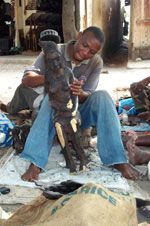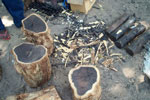|
AFRICAN BLACKWOOD
Common Name: African blackwood
Scientific Name: Dalbergia melanoxylon
Categories: Timber, National, Musical, Medicinal
National tree of Tanzania
Dalbergia melanoxylon (known in Kiswahili as mpingo) is a small, gnarled, heavily branched tree that grows extremely slowly, not reaching harvestable age for between 70 and 100 years. It has very dense, almost black heartwood that is currently harvested for international trade, mainly from Tanzania and Mozambique. Its other local names include babanus, grenadilla, Mozambique ebony, mufunjo, mugembe, and mukelete.
Why is this species important?
Mpingo is an important component of many ecosystems, including the open miombo woodland that covers two thirds of Tanzania. It is a nitrogen fixing species (of the Leguminosae family) that improves soil fertility. The tree is also good at maintaining soil stability. Its leaves provide fodder for migrating herbivores on the east African savannahs and for domestic livestock. The mature trees have the ability to survive fires that sweep through grasslands destroying other vegetation. The dark heartwood of mpingo, which gives it its western name of African blackwood, is one of the most economically valuable timbers in the world. It has exceptional mechanical properties that make it perfect for carving and it has a beautiful finish. It is used for carving intricate ornaments in Tanzania, and in the west is used to manufacture woodwind instruments. The loss of the export and carving industries in Tanzania would devastate local economies and would be disastrous for instrument manufacturers in the west.
Where is it found?
Mpingo grows under a wide range of environmental conditions and is native to 26 African countries. It ranges from northern Ethiopia, to the south in Angola, and spreads from Senegal across to Tanzania. It is often found on dry, rocky sites at elevations from sea level to 1200 m, although it is most frequent in the mixed deciduous forest and savannahs of the coastal regions of Tanzania and Mozambique.
How do people use it?
Mpingo has many traditional uses; a variety of ailments can be treated with medicines made from different parts of the tree. The leaves, bark and pods can all be used as animal fodder and the heart and sapwood can be burnt as high-energy fuel, or made into charcoal. In some areas, the wood is boiled to produce a broth that is used to bathe newborn babies, which is believed to impart strength.The heartwood is ideal for turning and carving because of its exceptional density. A lustrous finish can be achieved because it is naturally oily and finely grained. In Africa it is used to carve tools and utensils. The Makonde tribe, originally from northern Mozambique, carve ornaments that are sold to the tourist trade.In the west mpingo is used primarily to manufacture musical instruments such as clarinets, oboes and bagpipes, and there are considered to be no viable alternatives for top class woodwind instruments. Its exceptional density enables the intricate shapes of an instrument to be carved. It is highly durable, which protects the instrument from the acidity of saliva and oily hands. It is highly environmentally stable and does not distort when exposed to increased humidity. This is essential, as it prevents the tone and pitch altering significantly when the instrument is being played. Many musicians feel that mpingo instruments create beguiling and mellow tones that cannot be achieved with instruments made of alternative materials. For example, it is considered one of the better alternatives to Brazilian Rosewood for guitar backs and sides (see Soundwood page here).
Why is it threatened?
In countries such as Kenya, mpingo is considered to be seriously threatened. There is growing concern among instrument manufacturers that the supplies of high quality wood are becoming limited. Although mpingo is not likely to become biologically extinct, it is at high risk of becoming locally and commercially extinct. Economic extinction is a possibility for several reasons. Mature trees are being harvested at an apparently unsustainable rate. Only 10-20 percent of harvestable age trees contain timber suitable for export. The wood is brittle and shatters easily, therefore sections containing irregularities cannot be used for instruments. The trees are so twisted that only small sections can be used, and around 90 percent of the tree is wasted. A further quarter of exported timber is unsuitable due to hidden irregularities.Uncontrolled fires intended to clear land for agriculture kill young trees, and can cause heart rot in older trees, as they acquire fungus infections due to fire damage. Selective harvesting of straighter, taller trees may be causing ‘genetic erosion’ that may reduce the genetic quality of the population. Unsuitable characteristics may thus become more prevalent in future populations.
What conservation action is needed?
Various national measures have been taken to protect mpingo in countries where it occurs. In 1994, the Governments of Tanzania, Kenya and Germany proposed that the species be listed on Appendix II of CITES. African countries withdrew this to allow more discussion. In 1995 FFI co-hosted a workshop in Mozambique that produced an Action Plan for the species. Subsequently the Mpingo Project has undertaken research on the tree. As part of the Global Trees Campaign, FFI worked on a project entitled “Sustainable production and trade in African blackwood,” funded by the German Government and available to download below.
Selected references
Report on the International Trade in African Blackwood available to download here.
Gregory, A.M., Ball, S.M.J. and Eziefula, U.E. (1998). Tanzanian Mpingo '98. Full Report from the Cambridge Mpingo Project. On-line at: www.mpingoconservation.org
Platt, I. Evison, S. (1994). In-country investigation into the state of knowledge about the conservation and cultivation status of Mpingo (Dalbergia melanoxylon) in Tanzania. Fauna & Flora International, Cambridge UK.
Stockbauer B. (1999). A review of the literature. Supporting a rationale for mpingo conservation. African Blackwood Conservation Project. On-line at: www.blackwoodconservation.org
Back to Tree Profiles
|
CONSERVATION STATUS:

Near Threatened




|







